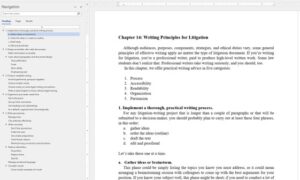According to a recent law-review article, the list below shows the most popular legal-writing advice books from 1998 to 2018 based on holdings in the WorldCat.org global catalog of library materials (excluding textbooks and reference manuals). More information below the table.
Source: Alexa Chew, The Fraternity of Legal Style, 20 Leg. Comm. & Rhetoric: JALWD 39, 46-47 (2023).
Figure 1.1 | Legal writing books included in this study, listed by popularity
| WorldCat Holdings | Author(s) | Title |
| 986 | Antonin Scalia & Bryan A. Garner |
Making Your Case: The Art of Persuading Judges |
| 965 | Bryan A. Garner | Legal Writing in Plain English: A Text with Exercises |
| 924 | Bryan A. Garner | The Elements of Legal Style |
| 797 | Bryan A. Garner | The Winning Brief: 100 Tips for Persuasive Briefing in Trial and Appellate Courts |
| 755 | Richard C. Wydick | Plain English for Lawyers |
| 538 | Ross Guberman | Point Made: How to Write Like the Nation’s Top Advocates |
| 446 | Tom Goldstein & Jethro K. Lieberman |
The Lawyer’s Guide to Writing Well |
| 413 | Stephen V. Armstrong & Timothy P. Terrell | Thinking Like a Writer: A Lawyer’s Guide to Effective Writing and Editing |
| 240 | Lynn Bahrych, Jeanne Merino & Beth McLellan | Legal Writing & Analysis in a Nutshell |
| 238 | Steven D. Stark | Writing to Win: The Legal Writer |
| 232 | Wayne Schiess | Preparing Legal Documents Nonlawyers Can Read and Understand |
| 230 | Sandra Oster | Writing Shorter Legal Documents: Strategies for Faster and Better Editing |
| 227 | Lenné Eidson Espenschied | The Grammar and Writing Handbook for Lawyers |
| 223 | Marie P. Buckley | The Lawyer’s Essential Guide to Writing: Proven Tools and Techniques |
| 211 | Jane N. Richmond | Legal Writing: Form and Function |
| 205 | Judith D. Fischer | Pleasing the Court: Writing Ethical and Effective Briefs |
| 196 | Wayne Schiess | Writing for the Legal Audience |
| 175 | Jayne Kracker | ABA Basic Guide to Punctuation, Grammar, Workplace Productivity, and Time Management |
| 173 | Austen L. Parrish & Dennis T. Yokoyama |
Effective Lawyering: A Checklist Approach to Legal Writing and Oral Argument |
Prof Chew’s article proves that in legal-writing advice books (which she calls “legal style books”) the sources cited and the examples given are mostly produced by men. In proving this claim, she created a list of the most popular legal-writing advice books for the period of 1998 to 2018. (She excluded legal-writing textbooks and legal-writing reference manuals.)
Ultimately, she produced a list of the most popular books for that period and then assessed the sources and examples in those books … and I was flabbergasted to see that I had two books on the list! Bryan Garner has four–hardly surprising–but I’m the only other person with more than one. Wow!



